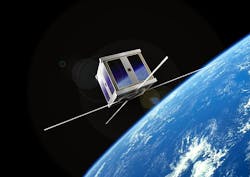NASA scientists plan near-Earth asteroid photo fly-by; ask industry for space-qualified color imaging camera
Officials of the NASA Jet Propulsion Laboratory (JPL) in Pasadena, Calif., issued a request for information (MJ-14-01) for the CubeSat-Sized Science Camera project, which is seeking potential contractors to provide science cameras for a CubeSat for use on a future deep-space mission.
JPL is part of the California Institute of Technology (Caltech), and operates under a prime contract to the U.S. National Aeronautics and Space Administration (NASA) in Washington.
The JPL's CubeSat-Sized Science Camera project is trying to judge current manufacturing capabilities and get a rough order of magnitude cost and schedule estimates to develop a science camera for a CubeSat.
The primary goal of the project is to develop a CubeSat camera to take scientific images of a near-Earth asteroid. From the CubeSat camera, JPL scientists want geological mapping of the asteroid at regional and local scales, volume estimation, rotation characterization, and colors. Operational goals have not been released.
The CubeSat camera should be ready to demonstrate in space per a technology readiness level (TRL) of 6 or higher, and should be ready for low-risk flight mission qualification. The CubeSat camera also should have a nominal lifetime of 2.5 years, and be able to minimize geometric and chromatic distortions.
Related: NASA seeks proposals for CubeSat nanosatellite space missions, payloads
JPL space scientists want a CubeSat camera that is smaller than half a liter, or no larger than the entire CubeSat, which takes up one whole liter. The camera's should be no longer than 13 centimeters, weigh no more than 1.1 pounds, consume less than 3 Watts, and have a field of view of at least 15 by 15 degrees.
The camera should be able to image in the 400 to 900 nanometer wavelength, take pictures at least as quickly as three frames per second, offer windowing capability, and have resolution at least as fine as 10 bits per pixel.
From companies JPL scientists want short descriptions of product candidates, mass, physical dimensions, preferred operating temperatures, raw data outputs, and any flight heritage.
Companies should email responses no later than 5 March 2014 to JPL's Michael Jacobs at [email protected], with Science Camera RFI Response in the subject line.
Email questions or concerns Michael Jacobs at [email protected]. More information is online at https://www.fbo.gov/spg/NASA/HQ/OPHQDC/MJ-14-01/listing.html.
About the Author
John Keller
Editor-in-Chief
John Keller is the Editor-in-Chief, Military & Aerospace Electronics Magazine--provides extensive coverage and analysis of enabling electronics and optoelectronic technologies in military, space and commercial aviation applications. John has been a member of the Military & Aerospace Electronics staff since 1989 and chief editor since 1995.
